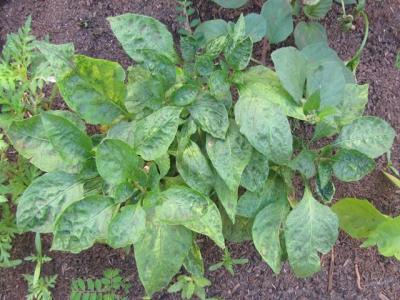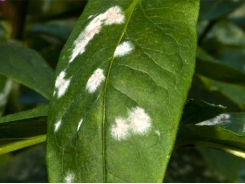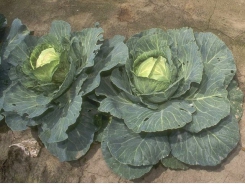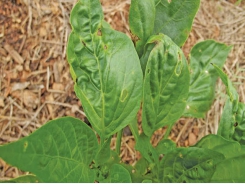Dealing with spotted wilt

Spotted wilt can be devastating in a land of peppers, but need not be if the correct strategies are adopted.
Typical spotted wilt symptoms on a capsicum plant. Photo: Bill Kerr
This disease is much easier to recognise than most of the other viruses to which peppers are susceptible. The symptoms are dark, irregular spots or lesions on the leaves. The leaves and growing tips also tend to hang, hence the Afrikaans name for this disease – kromnek (crooked neck). The disease was virtually unknown here until the Western flower thrip was introduced via imported chrysanthemum cuttings about 35 years ago. This is the main vector of spotted wilt and the disease spread to a number of crops, including lettuce.
Unfortunately, many weeds are also susceptible, and they act as a reservoir between crops. Some even do so without displaying the symptoms. At first, it was considered almost impossible to get under control without resistant varieties. This has changed as farmers have realised that weeds on the verges of the land may harbour the pathogen.A client of mine had a persistent problem with spotted wilt every year in his tunnels until the virus symptoms on overwintering weeds near the tunnels were pointed out to him. He killed these off and the problem was largely solved.
A lettuce farmer had the same problem and blamed the seedling nursery, as he had had a long break between lettuce crops.
On investigation, though, I noticed that the disease was far worse near a weedy verge. I was able to identify several species of weeds with obvious symptoms. This farmer now makes sure that he breaks the cycle by spraying these areas with herbicide.
Inspect the plot frequently
The capsicums on my plot were also affected by spotted wilt, and initially I thought I had to simply live with it. I then found symptoms on thistles, Malva and prickly wild lettuce. I now make sure that none of these overwinter on my property and this past season I did not have one plant with spotted wilt. Of course, removing infected weeds won’t guarantee that you will not find the disease in your crop, but the frequency is sure to be much lower.
The next step is to inspect the crop for early symptoms of the disease. (In fact, inspecting your crop frequently pays dividends whether there’s a virus threat or not.) If you spot any diseased plants, remove them immediately and put them in a clear plastic bag with the opening folded under the bag. Leave it in the sun to ‘cook’ the plant and any thrips that may still be present.
Once you’ve found an infected plant, it’s worthwhile carrying out daily inspections of the area in case there are more infected plants that have not yet started to display symptoms. You can stop an outbreak by doing this, provided there’s not a nearby source of thrips. Of course, if there are no thrips, there will be no spotted wilt, so killing the insects is another way of reducing the threat. A number of products are effective, and it’s best to get thrips under control before flowering commences.
As its name suggests, the Western flower thrip prefers flowers, but can settle elsewhere. However, it is much more difficult to control once it gets into flowers. At the same time, thrips are much easier to find in the flowers when you search for them.
Another potential solution, especially for farmers involved in organic production, is thrip predatory insects. These are sold by Koppert South Africa.
These can feed on the pollen when there are insufficient thrips to sustain them. They can be very effective and once well established, can significantly reduce thrip infestation. When feeding in the flower, thrips can also damage the skin of the ovary, which later develops into the pepper. These scars usually manifest as zipper-like stripes on the fruit, which is then downgraded.
Wilt-resistant varieties
Another solution is to grow spotted wilt-resistant varieties. The gene confers effective resistance against the disease and in areas where the problem is more persistent, this is the only option. You should expect to pay more for the seed, however.
Related news
Tools

Phối trộn thức ăn chăn nuôi

Pha dung dịch thủy canh

Định mức cho tôm ăn

Phối trộn phân bón NPK

Xác định tỷ lệ tôm sống

Chuyển đổi đơn vị phân bón

Xác định công suất sục khí

Chuyển đổi đơn vị tôm

Tính diện tích nhà kính

Tính thể tích ao



 Growing Chinese Cabbage in the Vegetable Garden
Growing Chinese Cabbage in the Vegetable Garden  Preventing bacterial spot in capsicums
Preventing bacterial spot in capsicums